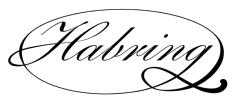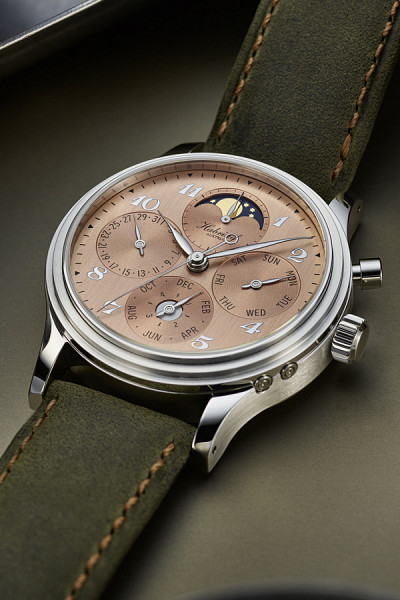Richard and Maria Habring.

In order to understand HABRING2, all you need to do is meet Richard and Maria.
During dinner we discussed Richard’s background and his years working at IWC. His initial training at IWC didn’t start with the workbench. He was assigned to work at the front end of manufacturing understanding how to transfer and document what he learned in school to production. He had the opportunity to meet and work with most of the production operators, learn their equipment and understand their likes and dislikes on the drawings they were given. Richard was apt to point out that front-end operations are often taken for granted. We like to look at the final assembly or finish process, but operations like setting the jewels in the mainplate are the foundation for the success of the assembly. This is typical of his personality and approach. He has a deep working knowledge and appreciation for every aspect of the watch design and execution. This lead to his successful working relationship at IWC and underlies his current emphasis of considering his suppliers as team members whose comments and ideas are important to the success of HABRING2
Working under Günter Blümlein he learned how the factory operated and the details of what was needed to bring his ideas to production. Richard was recognized for his ability to quickly design and prototype complications. His designs were being adapter to other Richmont brands. He become more and more in demand and found himself working all the time with little to no time off. He finally left IWC and eventually found himself working for A. Lange & Sohne as a consultant, again association with Günter Blümlein. I have not found a lot written about Günter Blümlein, who was a driving force in the watch industry. His early death left a void that will never be filled. Richard and Maria through the years have stayed close to their families, developing their business plan for the launch of HABRING2. Less than a year after the launch they moved their business Volkermart.
Their shop is located in the old city center.

A very colorful shop entrance

The Atelier is located in the front of the shop.


Behind Richard’s workbench he displays pictures of friends and teachers. A reminder of those that have influence his life.

Richard also displays a clock he made while in school

In the center of the shop, Maria manages the business. Maria has a very personable and gentle manor. In business, Maria maintains her gentle nature but has a strong drive to keep HABRING2 on a solid footing with suppliers. Some suppliers, who deal with large manufacturing houses, often put the work for small independent watchmakers on a “I’ll get to it when I can” basis. Most independents learn to accept this. Not Maria. She will call and ask to speak to the owner. She is willing to wait all day if necessary. Suppliers Richard worked with, either from his years at IWC or working as a consultant, remember him. Sometimes Maria is able to jog their memories when she talks with the owner. I’m not sure how she does it, but after talking with their suppliers, they often get on equal standing with the large manufacturing houses. Richard and Maria then travel to their suppliers once a year for a personal visit, spending a day with each one of them. They develop a team as opposed to finding new suppliers to reduce costs. Their goal is form a long term relationship with their key suppliers.
Even though the name on the watch reflects a joint venture between Richard and Maria, he discusses his brand as a team effort. I never heard him discuss his watches in the first person.
Richard and Maria are not interested in making large profits and building a large company. They truly do not care about the money. Richard makes it very clear that his primary goal is to enjoy his work. He wants to keep his volume low, support his consulting work, and keep designing and manufacturing new complications. I cannot publish what he has been doing as a consultant. What I can say is he has developed a new chronograph complication that was though to be extremely difficult to execute. You will probably hear about this in a release from a well known manufacturing house in the near future. Hopefully they will give a nod to Richard for his design and prototype.

The back of the shop contains some treasures. Anyone fortunate enough to own a Buben-Zoerweg Pantheon or Pythagoras tourbillon clock has a unit designed and hand made by Richard. I took a few quick hand held shots of these clocks in his vault.

Inside the plastic, the Buben-Zoerweg tourbillon clock

We wound the clock-up and watched the tourbillon. If you go to the Buben-Zoerweg web site they have the animation on this movement. He already has plans for some new designs that integrate the tourbillon onto larger clocks.


The shop is guarded by the third member of the Habring family, Max. Under that calm exterior lies the heart of a Rottweiler. When you meet Richard and Maria, Max will be there too.

We talked about the continued use of unique and vintage movements. To use a vintage movement, you first need to find a supply of good NOS parts. The movement needs to be disassembled down to the mainplate and rebuilt. In some areas, the vintage movement may have higher grade parts in comparison to modern ebauches. Overall, modern movements can maintain a higher machining tolerance due to the advances in manufacturing, materials and CNC tooling. This can translate into a higher reliability. Richard understands this balance and will start to add some new movements to his product line, which will have complications designed and manufactured by Richard. He will continue to offer some vintage movements and provide upgrades as part of his modular approach.
One of the new ebauches he will be integrating into his line is the ETA A07.xxx Valgranges. The movement is the same size as the Unitas 6498 (16.5’’’). This is a new ETA ebauch launched for larger watch cases, with new features being continuely added by ETA. This should be produced and supported by ETA for many years. Richard already has a large date complication integrated into this movement with the prototype being prepared for delivery. He has designed more complications for this base module that will be announced in the future.
His idea is producing 12 in an annual series will not change. For example, he does not believe in offering an annual series with 12 chronographs with a white dial, 12 in black, 12 in silver, etc. A series is the base movement with any color dial, case material, finish or additional complication that the customer wants.


